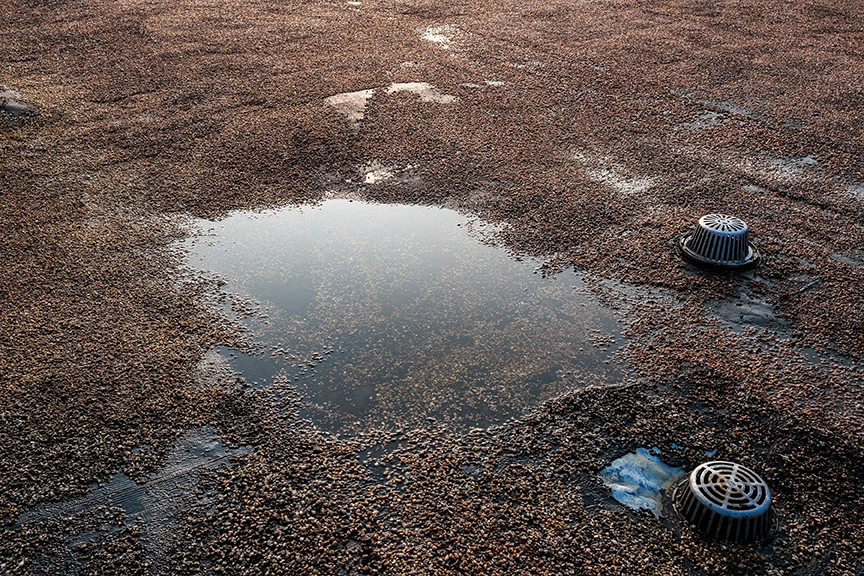Rain, Rain, Go Away: The Importance of Proper Roof Drainage
When it rains, it pours, and one of the most common causes of commercial roof damage is standing water. According to Architect magazine, 40 percent of all building-related problems are due to water intrusion—and water usually intrudes through roofs. In addition to rain, snow and ice-melt can also cause water issues. As such, ensuring proper drainage is of utmost importance on a flat or pitched commercial roof.

Flat Roofs vs. Pitched Roofs
A flat roof is a type of roofing design characterized by a nearly horizontal or very low slope. Flat roofs have a slight slope to improve drainage but are generally flat or close to it. Flat roofs are commonly used in commercial buildings and industrial facilities. Flat roofs are typically made of built-up roofing, modified bitumen, single-ply membranes, and spray polyurethane foam.
Pitched roofs, on the other hand, have a more pronounced angle that allows water, snow, ice-melt, and debris to run off easily. A commercial pitched roof style is normally made from asphalt shingles, clay, or concrete tiles.
Proper Drainage
Although there are many different commercial building roof types—single-ply, spray foam, metal, and shingle—for proper drainage to be achieved, a flat or sloped roof must have the proper drainage system installed by a professional commercial roofing contractor. Unfortunately, not all roofing contractors provide quality workmanship. If your roof was installed haphazardly due to carelessness or a lack of expertise by a contractor, a costly emergency roof repair service could be in your future. To prevent potential problems from occurring, facility managers should work with a roofing professional who is knowledgeable about positive drainage and can perform a roof inspection. Proper roof drainage is crucial for any factory or commercial facility for the following reasons.
Benefits of Proper Roof Drainage
Prevents Water Damage: Effective commercial roof drainage systems help prevent water from pooling or accumulating on a roof surface. In addition to contributing to leaks, roof deterioration, and potential water damage to the interior of a building, standing water can also encourage birds and mosquitoes to nest and for plants and fungus to grow. By facilitating the timely removal of rainwater, snow and ice-melt, proper drainage minimizes the risk of structural damage and costly repairs.
Extends Roof Lifespan: Excessive water retention on a roof can result in the accelerated deterioration of the roofing materials, including shingles, membranes, or metal panels. Metal roofs tend to suffer from rust at the seams if water does not drain properly, and mold can form on shingles and other types of roofing materials if there is standing water. By ensuring efficient and positive drainage, you can help extend the lifespan of a roof and avoid premature replacement or a roofing emergency.
Reduces Weight Load: Water is heavy, and when it accumulates on a roof, it adds significant mass. If the roof is not designed to handle excessive water buildup, it can lead to structural stress and potential collapse. Proper drainage systems help maintain an optimal weight load on a roof, reducing the risk of structural failure.
Prevents Ice Dam Formation: In colder climates, inadequate drainage can contribute to the formation of ice dams which occur when melted snow re-freezes near the roof’s edge, forming a barrier that prevents proper drainage. The trapped water can seep into the roofing system, causing leaks, water damage, and even compromising a building’s insulation. Adequate drainage helps mitigate the formation of ice dams by facilitating the proper flow of water off a roof.
Minimizes Moisture-Related Issues: Excessive moisture on a roof can lead to the growth of mold, algae, or moss, which can cause further damage to the roofing materials and compromise a building’s aesthetics. Proper drainage helps to reduce moisture buildup, minimizing the risk of these issues.
Supports Energy Efficiency: Standing water on a roof can negatively impact the insulation properties of a building. When water accumulates, it can create thermal bridges that allow heat to escape or enter the building more easily. Effective drainage helps maintain the insulation’s effectiveness, contributing to energy efficiency and reducing heating and cooling costs.
To ensure proper drainage on a factory or commercial roof, it is essential to have a well-designed commercial roof drainage system that includes gutter systems, downspouts, and drainage channels. All of these components should also be regularly inspected and maintained.
Components of a Commercial Roof Drainage System
Drains: Internal roof drains are usually found in the middle or along the perimeter of a roof. During regular roof maintenance, any visible debris should be removed from the drain areas to obtain proper water flow. All drainage components should also be inspected.
Scuppers: Perimeter-edge drains are called scuppers and are level with a roof surface. Scuppers are usually built into parapet walls and allow water to drain from the edge of the roof into collector boxes and downspouts.
Crickets and Saddles: This insulation is specifically cut and sloped to direct water into drains and scupper locations. These elements are most commonly found on low-sloped roofs because they effectively prevent water from pooling between drains.
Gutter Heads, Gutters, and Downspouts: These parts work together to make sure water is diverted from the roof to the ground. It is important to maintain your gutter/downspout system so water flows properly and gutter joints are properly sealed.
Each of these components of a commercial roof drainage system should be inspected and maintained regularly by a qualified roofing professional who can ensure there are no clogs and water flows smoothly. Furthermore, a qualified roofing professional can also help to identify and address any drainage issues promptly. Contact us to discuss proper roof drainage, to set up an industrial roof assessment, or to talk about a commercial roof maintenance program to ensure your flat or pitched roof is functioning properly.
Citation:
Architect Magazine: https://www.architectmagazine.com/technology/when-it-leaks-it-pours_o#:~:text=Roofs%2C%20on%20average%2C%20last%20only,water%20usually%20intrudes%20through%20roofs.